Operations and Project Management: Continuous Improvement Report
VerifiedAdded on 2020/10/22
|13
|2975
|169
Report
AI Summary
This report delves into the core principles of operations and project management, examining their application within organizations. It begins by outlining ten key principles of operations management, illustrated with examples from Marks & Spencer, and proposes a detailed continuous improvement plan based on these principles. The report then explores the effectiveness of this improvement plan, followed by a justification of the plan using concepts such as Six Sigma and Lean principles, including a critique of both. The analysis extends to project management, detailing the project life cycle and the application of agile project management theory, particularly in the context of improving Heathrow Terminal 3's baggage facility. The report concludes with an evaluation of the project life cycle's effectiveness and a rationale for its use, differentiating between large and small-scale projects.

OPERATIONS AND
PROJECT MANAGEMENT
PROJECT MANAGEMENT
Paraphrase This Document
Need a fresh take? Get an instant paraphrase of this document with our AI Paraphraser
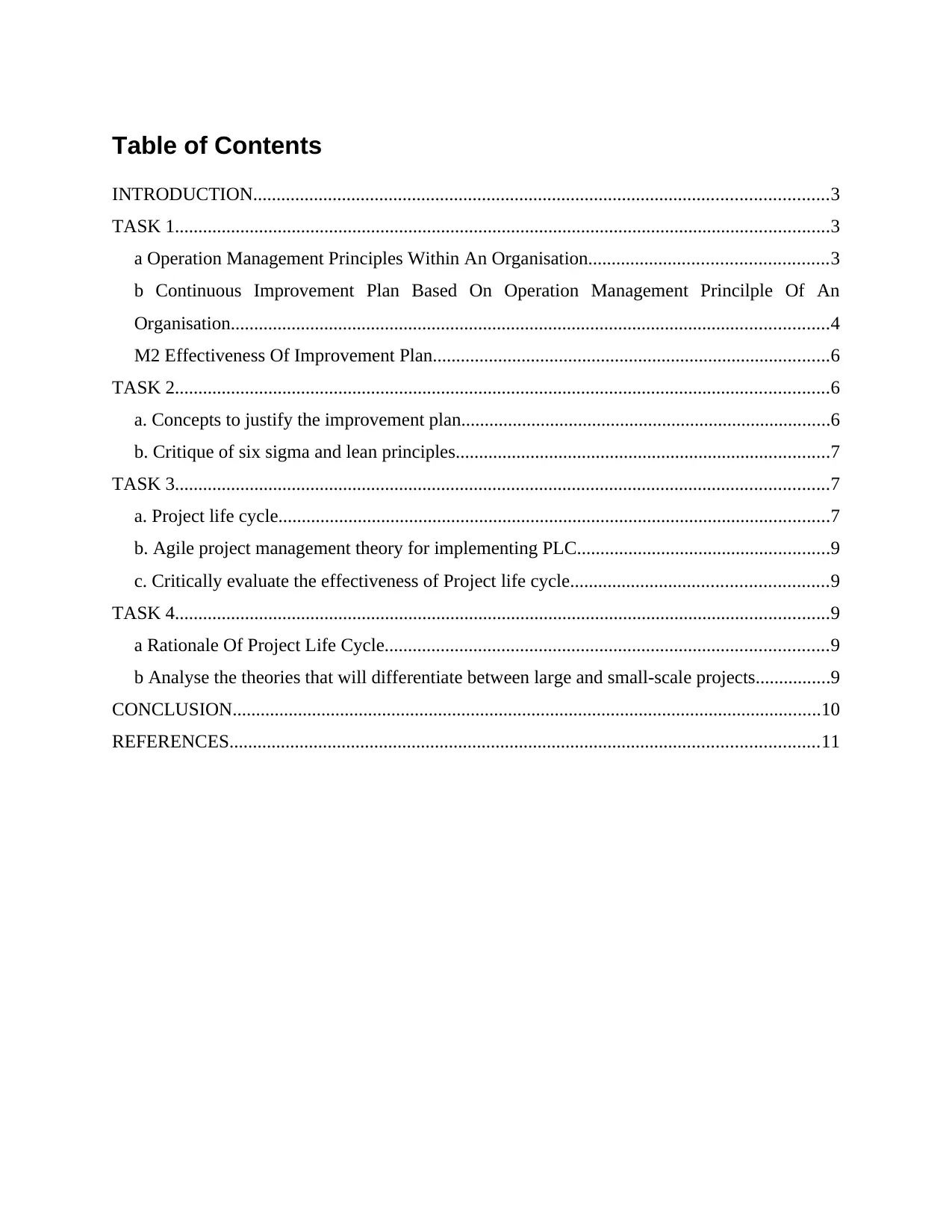
Table of Contents
INTRODUCTION...........................................................................................................................3
TASK 1............................................................................................................................................3
a Operation Management Principles Within An Organisation...................................................3
b Continuous Improvement Plan Based On Operation Management Princilple Of An
Organisation................................................................................................................................4
M2 Effectiveness Of Improvement Plan.....................................................................................6
TASK 2............................................................................................................................................6
a. Concepts to justify the improvement plan...............................................................................6
b. Critique of six sigma and lean principles................................................................................7
TASK 3............................................................................................................................................7
a. Project life cycle......................................................................................................................7
b. Agile project management theory for implementing PLC......................................................9
c. Critically evaluate the effectiveness of Project life cycle.......................................................9
TASK 4............................................................................................................................................9
a Rationale Of Project Life Cycle...............................................................................................9
b Analyse the theories that will differentiate between large and small-scale projects................9
CONCLUSION..............................................................................................................................10
REFERENCES..............................................................................................................................11
INTRODUCTION...........................................................................................................................3
TASK 1............................................................................................................................................3
a Operation Management Principles Within An Organisation...................................................3
b Continuous Improvement Plan Based On Operation Management Princilple Of An
Organisation................................................................................................................................4
M2 Effectiveness Of Improvement Plan.....................................................................................6
TASK 2............................................................................................................................................6
a. Concepts to justify the improvement plan...............................................................................6
b. Critique of six sigma and lean principles................................................................................7
TASK 3............................................................................................................................................7
a. Project life cycle......................................................................................................................7
b. Agile project management theory for implementing PLC......................................................9
c. Critically evaluate the effectiveness of Project life cycle.......................................................9
TASK 4............................................................................................................................................9
a Rationale Of Project Life Cycle...............................................................................................9
b Analyse the theories that will differentiate between large and small-scale projects................9
CONCLUSION..............................................................................................................................10
REFERENCES..............................................................................................................................11
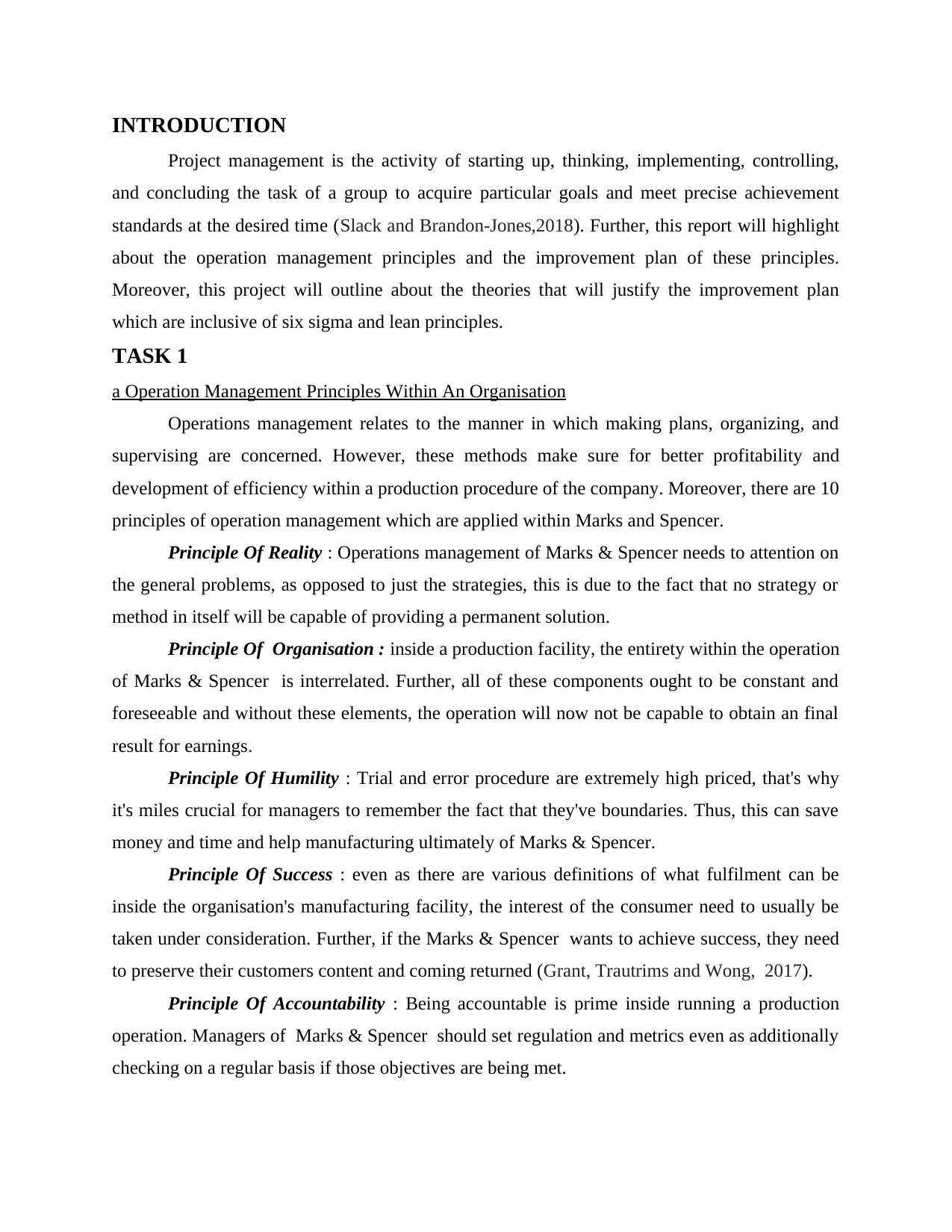
INTRODUCTION
Project management is the activity of starting up, thinking, implementing, controlling,
and concluding the task of a group to acquire particular goals and meet precise achievement
standards at the desired time (Slack and Brandon-Jones,2018). Further, this report will highlight
about the operation management principles and the improvement plan of these principles.
Moreover, this project will outline about the theories that will justify the improvement plan
which are inclusive of six sigma and lean principles.
TASK 1
a Operation Management Principles Within An Organisation
Operations management relates to the manner in which making plans, organizing, and
supervising are concerned. However, these methods make sure for better profitability and
development of efficiency within a production procedure of the company. Moreover, there are 10
principles of operation management which are applied within Marks and Spencer.
Principle Of Reality : Operations management of Marks & Spencer needs to attention on
the general problems, as opposed to just the strategies, this is due to the fact that no strategy or
method in itself will be capable of providing a permanent solution.
Principle Of Organisation : inside a production facility, the entirety within the operation
of Marks & Spencer is interrelated. Further, all of these components ought to be constant and
foreseeable and without these elements, the operation will now not be capable to obtain an final
result for earnings.
Principle Of Humility : Trial and error procedure are extremely high priced, that's why
it's miles crucial for managers to remember the fact that they've boundaries. Thus, this can save
money and time and help manufacturing ultimately of Marks & Spencer.
Principle Of Success : even as there are various definitions of what fulfilment can be
inside the organisation's manufacturing facility, the interest of the consumer need to usually be
taken under consideration. Further, if the Marks & Spencer wants to achieve success, they need
to preserve their customers content and coming returned (Grant, Trautrims and Wong, 2017).
Principle Of Accountability : Being accountable is prime inside running a production
operation. Managers of Marks & Spencer should set regulation and metrics even as additionally
checking on a regular basis if those objectives are being met.
Project management is the activity of starting up, thinking, implementing, controlling,
and concluding the task of a group to acquire particular goals and meet precise achievement
standards at the desired time (Slack and Brandon-Jones,2018). Further, this report will highlight
about the operation management principles and the improvement plan of these principles.
Moreover, this project will outline about the theories that will justify the improvement plan
which are inclusive of six sigma and lean principles.
TASK 1
a Operation Management Principles Within An Organisation
Operations management relates to the manner in which making plans, organizing, and
supervising are concerned. However, these methods make sure for better profitability and
development of efficiency within a production procedure of the company. Moreover, there are 10
principles of operation management which are applied within Marks and Spencer.
Principle Of Reality : Operations management of Marks & Spencer needs to attention on
the general problems, as opposed to just the strategies, this is due to the fact that no strategy or
method in itself will be capable of providing a permanent solution.
Principle Of Organisation : inside a production facility, the entirety within the operation
of Marks & Spencer is interrelated. Further, all of these components ought to be constant and
foreseeable and without these elements, the operation will now not be capable to obtain an final
result for earnings.
Principle Of Humility : Trial and error procedure are extremely high priced, that's why
it's miles crucial for managers to remember the fact that they've boundaries. Thus, this can save
money and time and help manufacturing ultimately of Marks & Spencer.
Principle Of Success : even as there are various definitions of what fulfilment can be
inside the organisation's manufacturing facility, the interest of the consumer need to usually be
taken under consideration. Further, if the Marks & Spencer wants to achieve success, they need
to preserve their customers content and coming returned (Grant, Trautrims and Wong, 2017).
Principle Of Accountability : Being accountable is prime inside running a production
operation. Managers of Marks & Spencer should set regulation and metrics even as additionally
checking on a regular basis if those objectives are being met.
⊘ This is a preview!⊘
Do you want full access?
Subscribe today to unlock all pages.

Trusted by 1+ million students worldwide
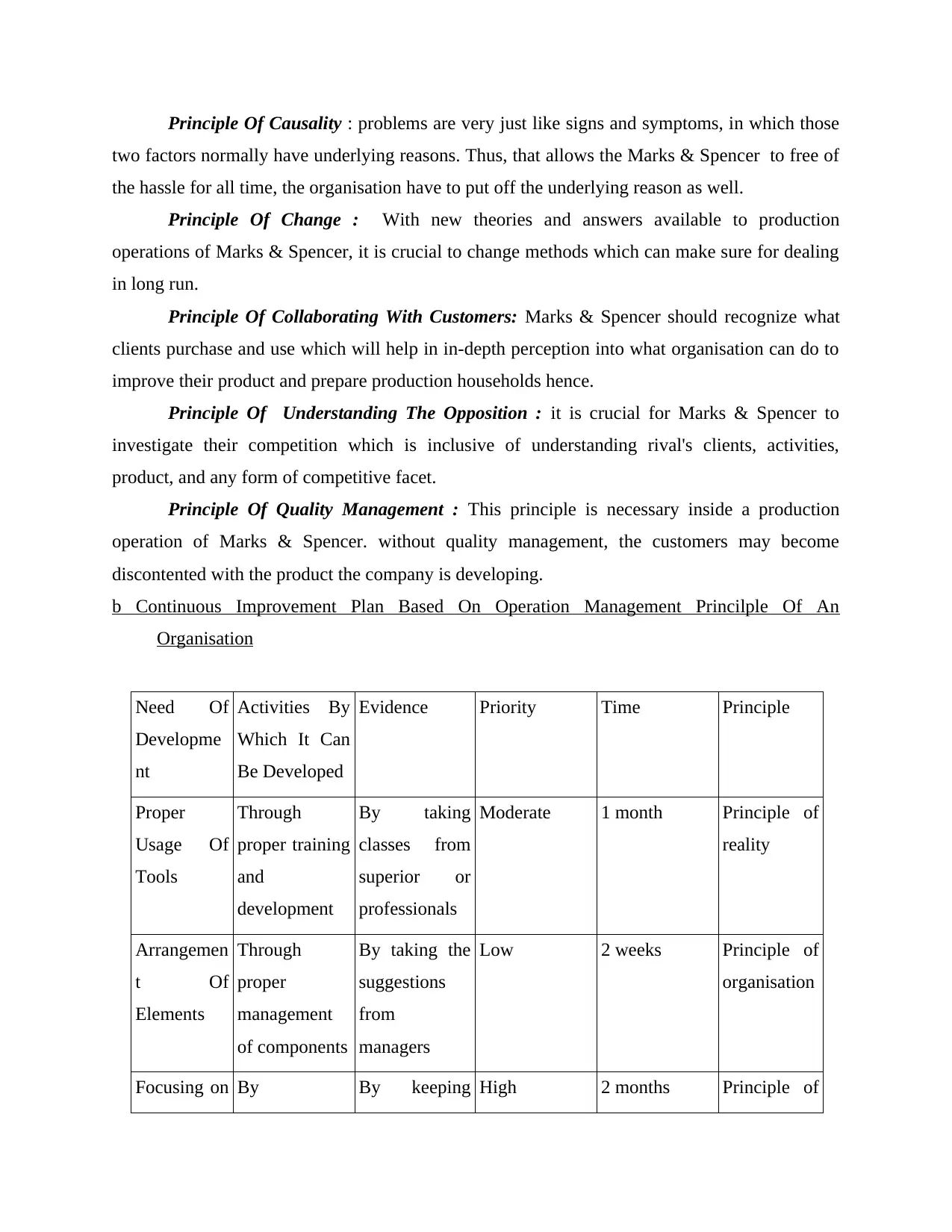
Principle Of Causality : problems are very just like signs and symptoms, in which those
two factors normally have underlying reasons. Thus, that allows the Marks & Spencer to free of
the hassle for all time, the organisation have to put off the underlying reason as well.
Principle Of Change : With new theories and answers available to production
operations of Marks & Spencer, it is crucial to change methods which can make sure for dealing
in long run.
Principle Of Collaborating With Customers: Marks & Spencer should recognize what
clients purchase and use which will help in in-depth perception into what organisation can do to
improve their product and prepare production households hence.
Principle Of Understanding The Opposition : it is crucial for Marks & Spencer to
investigate their competition which is inclusive of understanding rival's clients, activities,
product, and any form of competitive facet.
Principle Of Quality Management : This principle is necessary inside a production
operation of Marks & Spencer. without quality management, the customers may become
discontented with the product the company is developing.
b Continuous Improvement Plan Based On Operation Management Princilple Of An
Organisation
Need Of
Developme
nt
Activities By
Which It Can
Be Developed
Evidence Priority Time Principle
Proper
Usage Of
Tools
Through
proper training
and
development
By taking
classes from
superior or
professionals
Moderate 1 month Principle of
reality
Arrangemen
t Of
Elements
Through
proper
management
of components
By taking the
suggestions
from
managers
Low 2 weeks Principle of
organisation
Focusing on By By keeping High 2 months Principle of
two factors normally have underlying reasons. Thus, that allows the Marks & Spencer to free of
the hassle for all time, the organisation have to put off the underlying reason as well.
Principle Of Change : With new theories and answers available to production
operations of Marks & Spencer, it is crucial to change methods which can make sure for dealing
in long run.
Principle Of Collaborating With Customers: Marks & Spencer should recognize what
clients purchase and use which will help in in-depth perception into what organisation can do to
improve their product and prepare production households hence.
Principle Of Understanding The Opposition : it is crucial for Marks & Spencer to
investigate their competition which is inclusive of understanding rival's clients, activities,
product, and any form of competitive facet.
Principle Of Quality Management : This principle is necessary inside a production
operation of Marks & Spencer. without quality management, the customers may become
discontented with the product the company is developing.
b Continuous Improvement Plan Based On Operation Management Princilple Of An
Organisation
Need Of
Developme
nt
Activities By
Which It Can
Be Developed
Evidence Priority Time Principle
Proper
Usage Of
Tools
Through
proper training
and
development
By taking
classes from
superior or
professionals
Moderate 1 month Principle of
reality
Arrangemen
t Of
Elements
Through
proper
management
of components
By taking the
suggestions
from
managers
Low 2 weeks Principle of
organisation
Focusing on By By keeping High 2 months Principle of
Paraphrase This Document
Need a fresh take? Get an instant paraphrase of this document with our AI Paraphraser
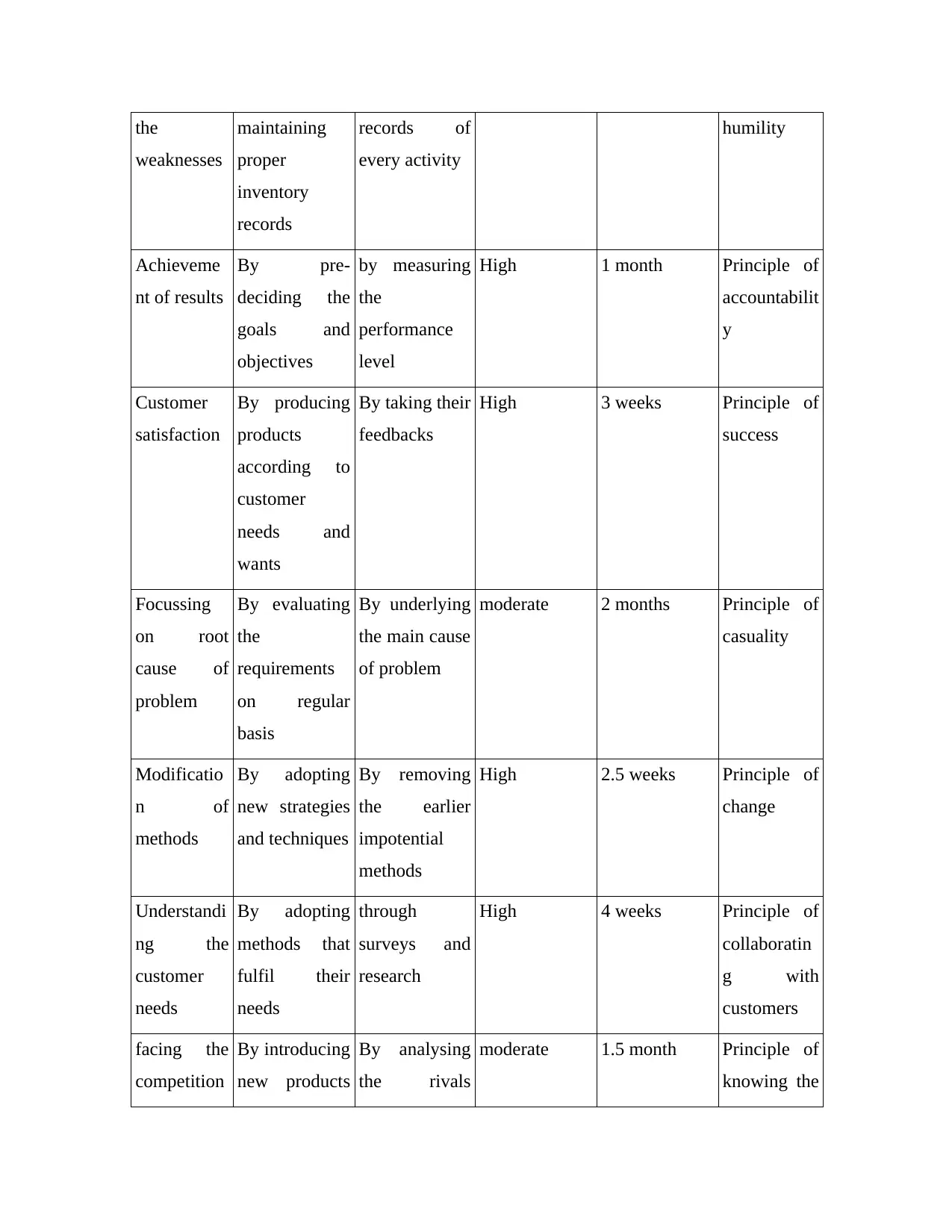
the
weaknesses
maintaining
proper
inventory
records
records of
every activity
humility
Achieveme
nt of results
By pre-
deciding the
goals and
objectives
by measuring
the
performance
level
High 1 month Principle of
accountabilit
y
Customer
satisfaction
By producing
products
according to
customer
needs and
wants
By taking their
feedbacks
High 3 weeks Principle of
success
Focussing
on root
cause of
problem
By evaluating
the
requirements
on regular
basis
By underlying
the main cause
of problem
moderate 2 months Principle of
casuality
Modificatio
n of
methods
By adopting
new strategies
and techniques
By removing
the earlier
impotential
methods
High 2.5 weeks Principle of
change
Understandi
ng the
customer
needs
By adopting
methods that
fulfil their
needs
through
surveys and
research
High 4 weeks Principle of
collaboratin
g with
customers
facing the
competition
By introducing
new products
By analysing
the rivals
moderate 1.5 month Principle of
knowing the
weaknesses
maintaining
proper
inventory
records
records of
every activity
humility
Achieveme
nt of results
By pre-
deciding the
goals and
objectives
by measuring
the
performance
level
High 1 month Principle of
accountabilit
y
Customer
satisfaction
By producing
products
according to
customer
needs and
wants
By taking their
feedbacks
High 3 weeks Principle of
success
Focussing
on root
cause of
problem
By evaluating
the
requirements
on regular
basis
By underlying
the main cause
of problem
moderate 2 months Principle of
casuality
Modificatio
n of
methods
By adopting
new strategies
and techniques
By removing
the earlier
impotential
methods
High 2.5 weeks Principle of
change
Understandi
ng the
customer
needs
By adopting
methods that
fulfil their
needs
through
surveys and
research
High 4 weeks Principle of
collaboratin
g with
customers
facing the
competition
By introducing
new products
By analysing
the rivals
moderate 1.5 month Principle of
knowing the
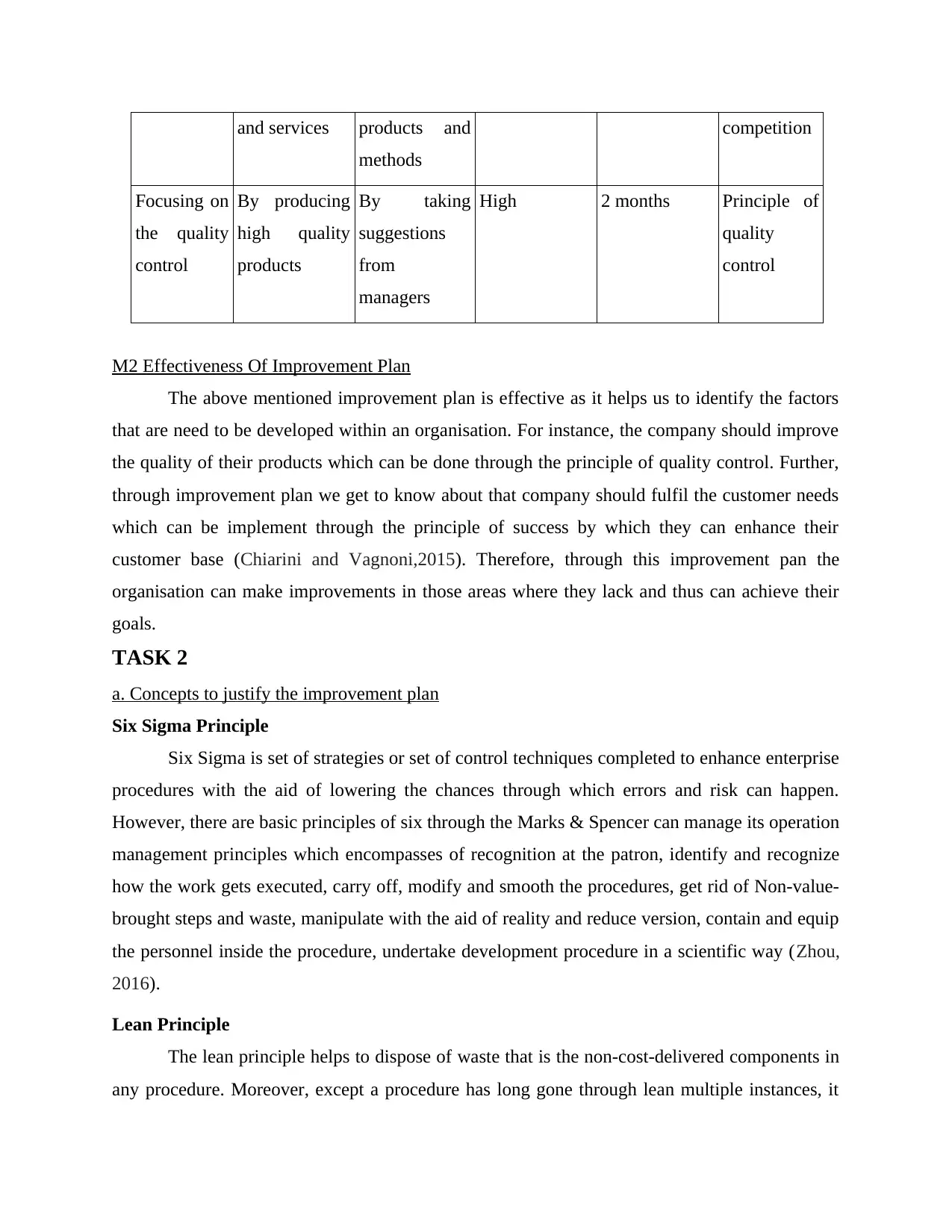
and services products and
methods
competition
Focusing on
the quality
control
By producing
high quality
products
By taking
suggestions
from
managers
High 2 months Principle of
quality
control
M2 Effectiveness Of Improvement Plan
The above mentioned improvement plan is effective as it helps us to identify the factors
that are need to be developed within an organisation. For instance, the company should improve
the quality of their products which can be done through the principle of quality control. Further,
through improvement plan we get to know about that company should fulfil the customer needs
which can be implement through the principle of success by which they can enhance their
customer base (Chiarini and Vagnoni,2015). Therefore, through this improvement pan the
organisation can make improvements in those areas where they lack and thus can achieve their
goals.
TASK 2
a. Concepts to justify the improvement plan
Six Sigma Principle
Six Sigma is set of strategies or set of control techniques completed to enhance enterprise
procedures with the aid of lowering the chances through which errors and risk can happen.
However, there are basic principles of six through the Marks & Spencer can manage its operation
management principles which encompasses of recognition at the patron, identify and recognize
how the work gets executed, carry off, modify and smooth the procedures, get rid of Non-value-
brought steps and waste, manipulate with the aid of reality and reduce version, contain and equip
the personnel inside the procedure, undertake development procedure in a scientific way (Zhou,
2016).
Lean Principle
The lean principle helps to dispose of waste that is the non-cost-delivered components in
any procedure. Moreover, except a procedure has long gone through lean multiple instances, it
methods
competition
Focusing on
the quality
control
By producing
high quality
products
By taking
suggestions
from
managers
High 2 months Principle of
quality
control
M2 Effectiveness Of Improvement Plan
The above mentioned improvement plan is effective as it helps us to identify the factors
that are need to be developed within an organisation. For instance, the company should improve
the quality of their products which can be done through the principle of quality control. Further,
through improvement plan we get to know about that company should fulfil the customer needs
which can be implement through the principle of success by which they can enhance their
customer base (Chiarini and Vagnoni,2015). Therefore, through this improvement pan the
organisation can make improvements in those areas where they lack and thus can achieve their
goals.
TASK 2
a. Concepts to justify the improvement plan
Six Sigma Principle
Six Sigma is set of strategies or set of control techniques completed to enhance enterprise
procedures with the aid of lowering the chances through which errors and risk can happen.
However, there are basic principles of six through the Marks & Spencer can manage its operation
management principles which encompasses of recognition at the patron, identify and recognize
how the work gets executed, carry off, modify and smooth the procedures, get rid of Non-value-
brought steps and waste, manipulate with the aid of reality and reduce version, contain and equip
the personnel inside the procedure, undertake development procedure in a scientific way (Zhou,
2016).
Lean Principle
The lean principle helps to dispose of waste that is the non-cost-delivered components in
any procedure. Moreover, except a procedure has long gone through lean multiple instances, it
⊘ This is a preview!⊘
Do you want full access?
Subscribe today to unlock all pages.

Trusted by 1+ million students worldwide
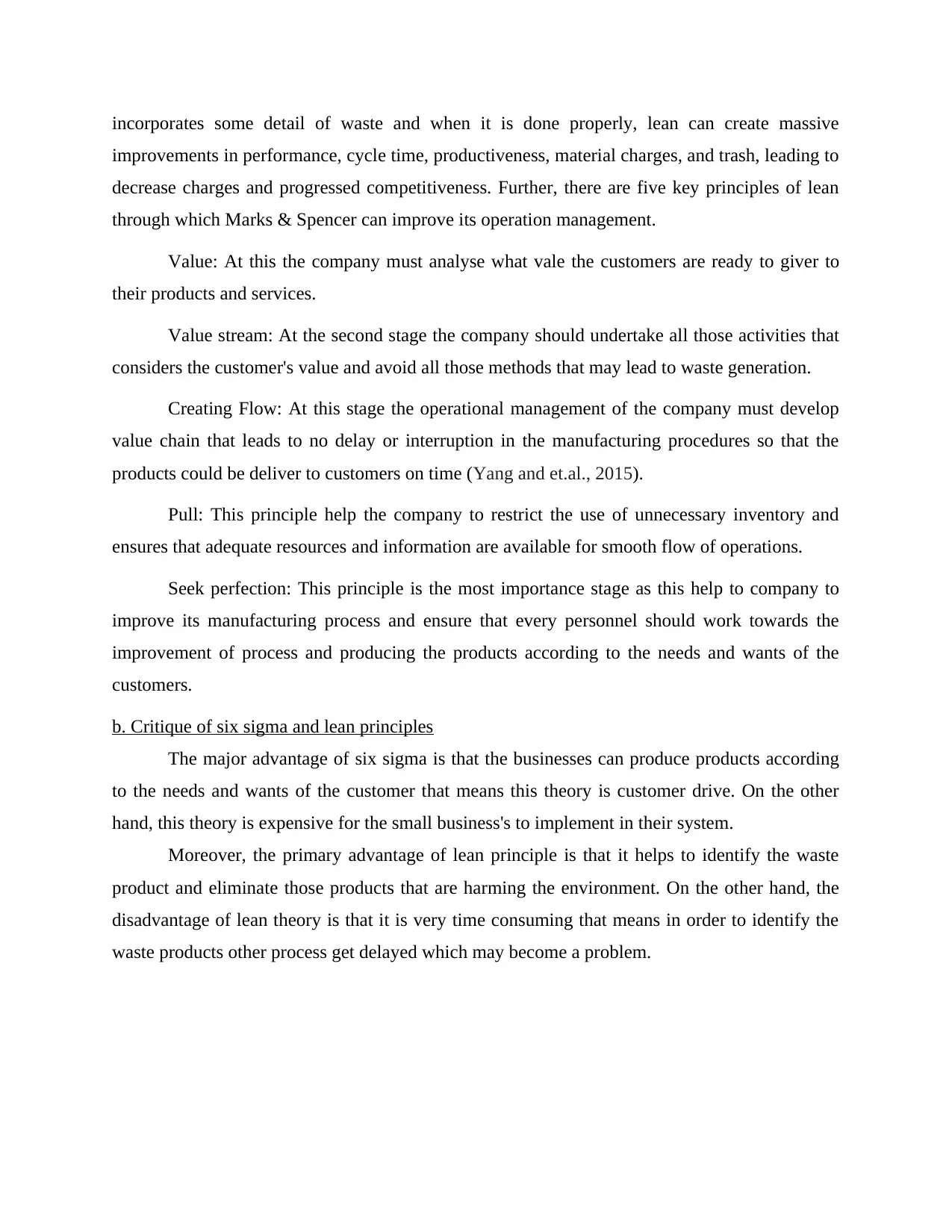
incorporates some detail of waste and when it is done properly, lean can create massive
improvements in performance, cycle time, productiveness, material charges, and trash, leading to
decrease charges and progressed competitiveness. Further, there are five key principles of lean
through which Marks & Spencer can improve its operation management.
Value: At this the company must analyse what vale the customers are ready to giver to
their products and services.
Value stream: At the second stage the company should undertake all those activities that
considers the customer's value and avoid all those methods that may lead to waste generation.
Creating Flow: At this stage the operational management of the company must develop
value chain that leads to no delay or interruption in the manufacturing procedures so that the
products could be deliver to customers on time (Yang and et.al., 2015).
Pull: This principle help the company to restrict the use of unnecessary inventory and
ensures that adequate resources and information are available for smooth flow of operations.
Seek perfection: This principle is the most importance stage as this help to company to
improve its manufacturing process and ensure that every personnel should work towards the
improvement of process and producing the products according to the needs and wants of the
customers.
b. Critique of six sigma and lean principles
The major advantage of six sigma is that the businesses can produce products according
to the needs and wants of the customer that means this theory is customer drive. On the other
hand, this theory is expensive for the small business's to implement in their system.
Moreover, the primary advantage of lean principle is that it helps to identify the waste
product and eliminate those products that are harming the environment. On the other hand, the
disadvantage of lean theory is that it is very time consuming that means in order to identify the
waste products other process get delayed which may become a problem.
improvements in performance, cycle time, productiveness, material charges, and trash, leading to
decrease charges and progressed competitiveness. Further, there are five key principles of lean
through which Marks & Spencer can improve its operation management.
Value: At this the company must analyse what vale the customers are ready to giver to
their products and services.
Value stream: At the second stage the company should undertake all those activities that
considers the customer's value and avoid all those methods that may lead to waste generation.
Creating Flow: At this stage the operational management of the company must develop
value chain that leads to no delay or interruption in the manufacturing procedures so that the
products could be deliver to customers on time (Yang and et.al., 2015).
Pull: This principle help the company to restrict the use of unnecessary inventory and
ensures that adequate resources and information are available for smooth flow of operations.
Seek perfection: This principle is the most importance stage as this help to company to
improve its manufacturing process and ensure that every personnel should work towards the
improvement of process and producing the products according to the needs and wants of the
customers.
b. Critique of six sigma and lean principles
The major advantage of six sigma is that the businesses can produce products according
to the needs and wants of the customer that means this theory is customer drive. On the other
hand, this theory is expensive for the small business's to implement in their system.
Moreover, the primary advantage of lean principle is that it helps to identify the waste
product and eliminate those products that are harming the environment. On the other hand, the
disadvantage of lean theory is that it is very time consuming that means in order to identify the
waste products other process get delayed which may become a problem.
Paraphrase This Document
Need a fresh take? Get an instant paraphrase of this document with our AI Paraphraser
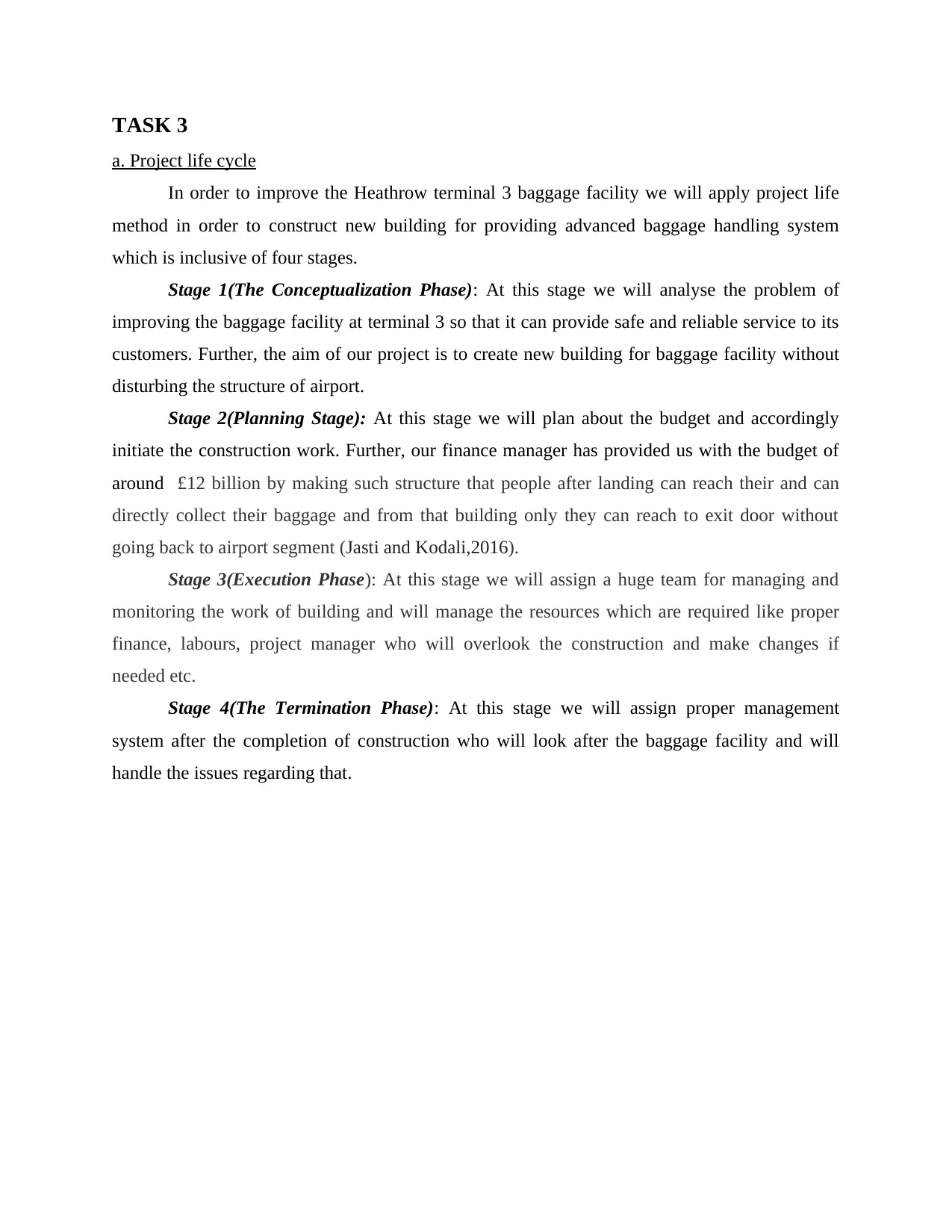
TASK 3
a. Project life cycle
In order to improve the Heathrow terminal 3 baggage facility we will apply project life
method in order to construct new building for providing advanced baggage handling system
which is inclusive of four stages.
Stage 1(The Conceptualization Phase): At this stage we will analyse the problem of
improving the baggage facility at terminal 3 so that it can provide safe and reliable service to its
customers. Further, the aim of our project is to create new building for baggage facility without
disturbing the structure of airport.
Stage 2(Planning Stage): At this stage we will plan about the budget and accordingly
initiate the construction work. Further, our finance manager has provided us with the budget of
around £12 billion by making such structure that people after landing can reach their and can
directly collect their baggage and from that building only they can reach to exit door without
going back to airport segment (Jasti and Kodali,2016).
Stage 3(Execution Phase): At this stage we will assign a huge team for managing and
monitoring the work of building and will manage the resources which are required like proper
finance, labours, project manager who will overlook the construction and make changes if
needed etc.
Stage 4(The Termination Phase): At this stage we will assign proper management
system after the completion of construction who will look after the baggage facility and will
handle the issues regarding that.
a. Project life cycle
In order to improve the Heathrow terminal 3 baggage facility we will apply project life
method in order to construct new building for providing advanced baggage handling system
which is inclusive of four stages.
Stage 1(The Conceptualization Phase): At this stage we will analyse the problem of
improving the baggage facility at terminal 3 so that it can provide safe and reliable service to its
customers. Further, the aim of our project is to create new building for baggage facility without
disturbing the structure of airport.
Stage 2(Planning Stage): At this stage we will plan about the budget and accordingly
initiate the construction work. Further, our finance manager has provided us with the budget of
around £12 billion by making such structure that people after landing can reach their and can
directly collect their baggage and from that building only they can reach to exit door without
going back to airport segment (Jasti and Kodali,2016).
Stage 3(Execution Phase): At this stage we will assign a huge team for managing and
monitoring the work of building and will manage the resources which are required like proper
finance, labours, project manager who will overlook the construction and make changes if
needed etc.
Stage 4(The Termination Phase): At this stage we will assign proper management
system after the completion of construction who will look after the baggage facility and will
handle the issues regarding that.
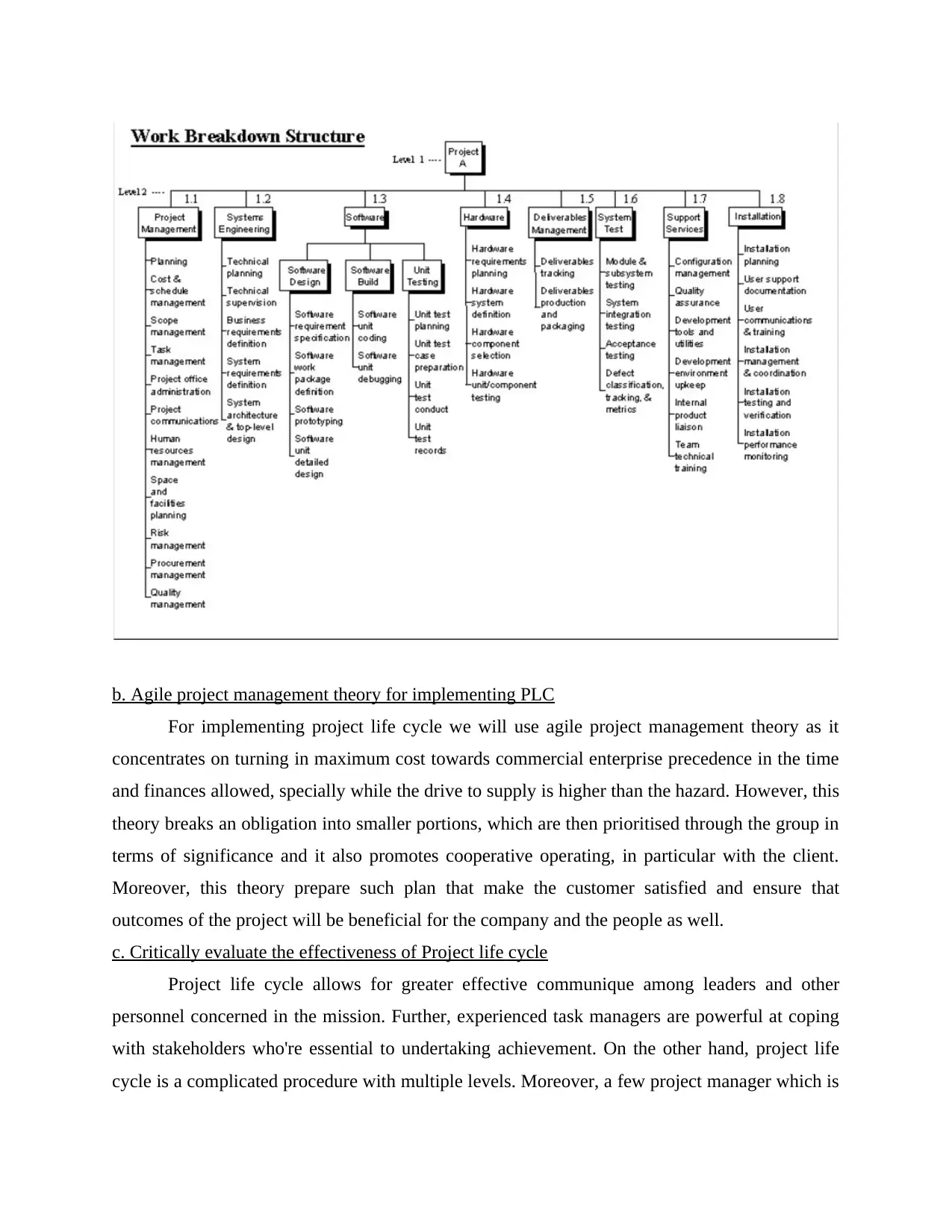
b. Agile project management theory for implementing PLC
For implementing project life cycle we will use agile project management theory as it
concentrates on turning in maximum cost towards commercial enterprise precedence in the time
and finances allowed, specially while the drive to supply is higher than the hazard. However, this
theory breaks an obligation into smaller portions, which are then prioritised through the group in
terms of significance and it also promotes cooperative operating, in particular with the client.
Moreover, this theory prepare such plan that make the customer satisfied and ensure that
outcomes of the project will be beneficial for the company and the people as well.
c. Critically evaluate the effectiveness of Project life cycle
Project life cycle allows for greater effective communique among leaders and other
personnel concerned in the mission. Further, experienced task managers are powerful at coping
with stakeholders who're essential to undertaking achievement. On the other hand, project life
cycle is a complicated procedure with multiple levels. Moreover, a few project manager which is
For implementing project life cycle we will use agile project management theory as it
concentrates on turning in maximum cost towards commercial enterprise precedence in the time
and finances allowed, specially while the drive to supply is higher than the hazard. However, this
theory breaks an obligation into smaller portions, which are then prioritised through the group in
terms of significance and it also promotes cooperative operating, in particular with the client.
Moreover, this theory prepare such plan that make the customer satisfied and ensure that
outcomes of the project will be beneficial for the company and the people as well.
c. Critically evaluate the effectiveness of Project life cycle
Project life cycle allows for greater effective communique among leaders and other
personnel concerned in the mission. Further, experienced task managers are powerful at coping
with stakeholders who're essential to undertaking achievement. On the other hand, project life
cycle is a complicated procedure with multiple levels. Moreover, a few project manager which is
⊘ This is a preview!⊘
Do you want full access?
Subscribe today to unlock all pages.

Trusted by 1+ million students worldwide
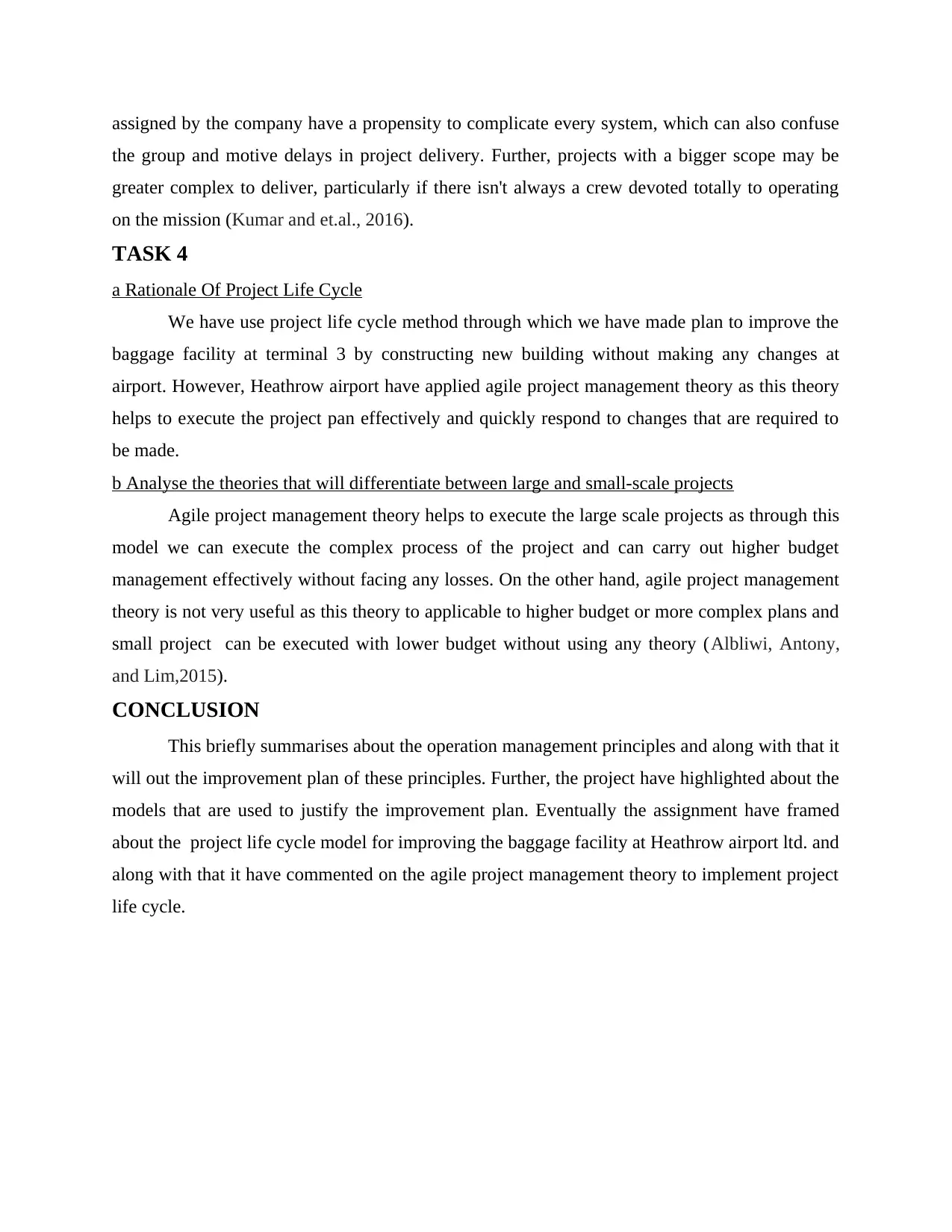
assigned by the company have a propensity to complicate every system, which can also confuse
the group and motive delays in project delivery. Further, projects with a bigger scope may be
greater complex to deliver, particularly if there isn't always a crew devoted totally to operating
on the mission (Kumar and et.al., 2016).
TASK 4
a Rationale Of Project Life Cycle
We have use project life cycle method through which we have made plan to improve the
baggage facility at terminal 3 by constructing new building without making any changes at
airport. However, Heathrow airport have applied agile project management theory as this theory
helps to execute the project pan effectively and quickly respond to changes that are required to
be made.
b Analyse the theories that will differentiate between large and small-scale projects
Agile project management theory helps to execute the large scale projects as through this
model we can execute the complex process of the project and can carry out higher budget
management effectively without facing any losses. On the other hand, agile project management
theory is not very useful as this theory to applicable to higher budget or more complex plans and
small project can be executed with lower budget without using any theory (Albliwi, Antony,
and Lim,2015).
CONCLUSION
This briefly summarises about the operation management principles and along with that it
will out the improvement plan of these principles. Further, the project have highlighted about the
models that are used to justify the improvement plan. Eventually the assignment have framed
about the project life cycle model for improving the baggage facility at Heathrow airport ltd. and
along with that it have commented on the agile project management theory to implement project
life cycle.
the group and motive delays in project delivery. Further, projects with a bigger scope may be
greater complex to deliver, particularly if there isn't always a crew devoted totally to operating
on the mission (Kumar and et.al., 2016).
TASK 4
a Rationale Of Project Life Cycle
We have use project life cycle method through which we have made plan to improve the
baggage facility at terminal 3 by constructing new building without making any changes at
airport. However, Heathrow airport have applied agile project management theory as this theory
helps to execute the project pan effectively and quickly respond to changes that are required to
be made.
b Analyse the theories that will differentiate between large and small-scale projects
Agile project management theory helps to execute the large scale projects as through this
model we can execute the complex process of the project and can carry out higher budget
management effectively without facing any losses. On the other hand, agile project management
theory is not very useful as this theory to applicable to higher budget or more complex plans and
small project can be executed with lower budget without using any theory (Albliwi, Antony,
and Lim,2015).
CONCLUSION
This briefly summarises about the operation management principles and along with that it
will out the improvement plan of these principles. Further, the project have highlighted about the
models that are used to justify the improvement plan. Eventually the assignment have framed
about the project life cycle model for improving the baggage facility at Heathrow airport ltd. and
along with that it have commented on the agile project management theory to implement project
life cycle.
Paraphrase This Document
Need a fresh take? Get an instant paraphrase of this document with our AI Paraphraser
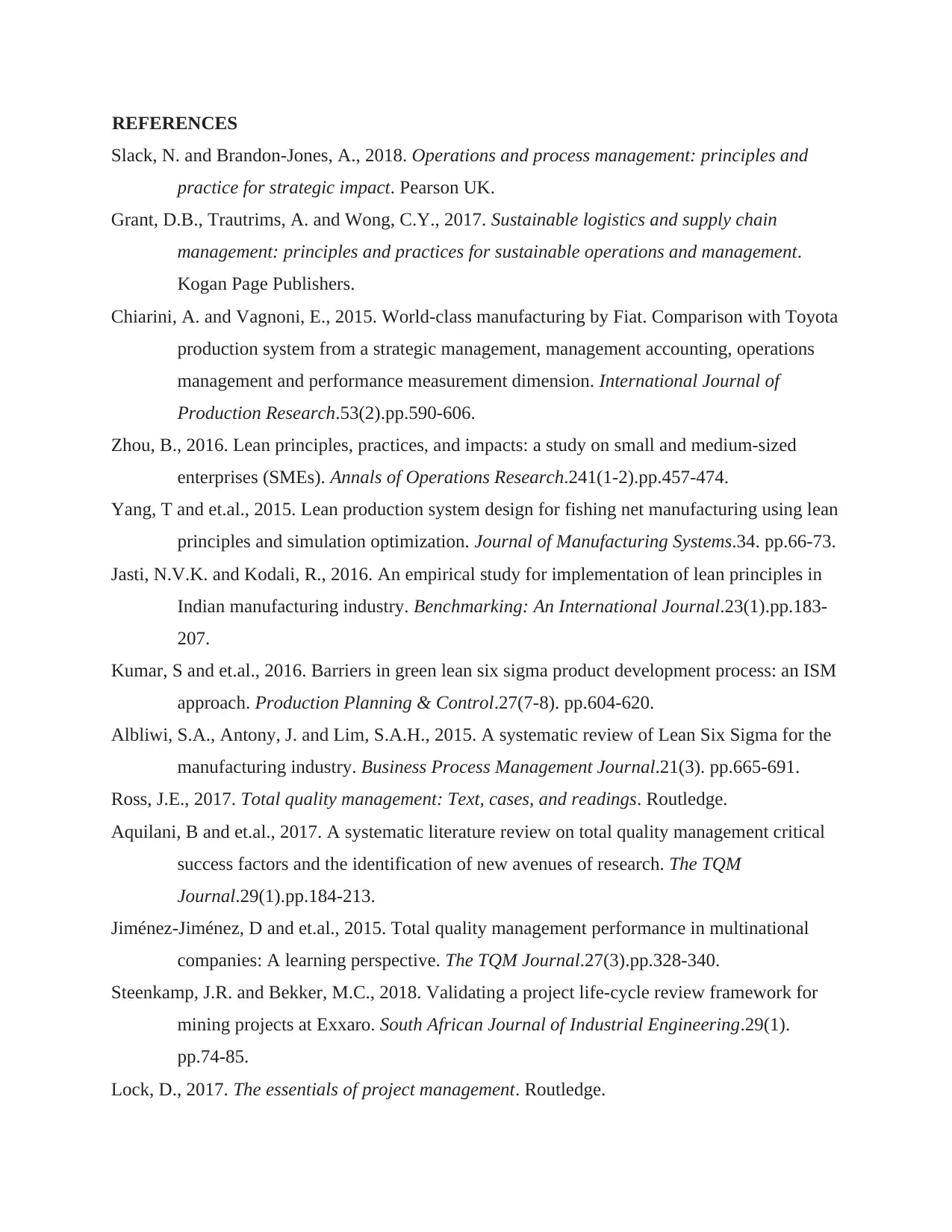
REFERENCES
Slack, N. and Brandon-Jones, A., 2018. Operations and process management: principles and
practice for strategic impact. Pearson UK.
Grant, D.B., Trautrims, A. and Wong, C.Y., 2017. Sustainable logistics and supply chain
management: principles and practices for sustainable operations and management.
Kogan Page Publishers.
Chiarini, A. and Vagnoni, E., 2015. World-class manufacturing by Fiat. Comparison with Toyota
production system from a strategic management, management accounting, operations
management and performance measurement dimension. International Journal of
Production Research.53(2).pp.590-606.
Zhou, B., 2016. Lean principles, practices, and impacts: a study on small and medium-sized
enterprises (SMEs). Annals of Operations Research.241(1-2).pp.457-474.
Yang, T and et.al., 2015. Lean production system design for fishing net manufacturing using lean
principles and simulation optimization. Journal of Manufacturing Systems.34. pp.66-73.
Jasti, N.V.K. and Kodali, R., 2016. An empirical study for implementation of lean principles in
Indian manufacturing industry. Benchmarking: An International Journal.23(1).pp.183-
207.
Kumar, S and et.al., 2016. Barriers in green lean six sigma product development process: an ISM
approach. Production Planning & Control.27(7-8). pp.604-620.
Albliwi, S.A., Antony, J. and Lim, S.A.H., 2015. A systematic review of Lean Six Sigma for the
manufacturing industry. Business Process Management Journal.21(3). pp.665-691.
Ross, J.E., 2017. Total quality management: Text, cases, and readings. Routledge.
Aquilani, B and et.al., 2017. A systematic literature review on total quality management critical
success factors and the identification of new avenues of research. The TQM
Journal.29(1).pp.184-213.
Jiménez-Jiménez, D and et.al., 2015. Total quality management performance in multinational
companies: A learning perspective. The TQM Journal.27(3).pp.328-340.
Steenkamp, J.R. and Bekker, M.C., 2018. Validating a project life-cycle review framework for
mining projects at Exxaro. South African Journal of Industrial Engineering.29(1).
pp.74-85.
Lock, D., 2017. The essentials of project management. Routledge.
Slack, N. and Brandon-Jones, A., 2018. Operations and process management: principles and
practice for strategic impact. Pearson UK.
Grant, D.B., Trautrims, A. and Wong, C.Y., 2017. Sustainable logistics and supply chain
management: principles and practices for sustainable operations and management.
Kogan Page Publishers.
Chiarini, A. and Vagnoni, E., 2015. World-class manufacturing by Fiat. Comparison with Toyota
production system from a strategic management, management accounting, operations
management and performance measurement dimension. International Journal of
Production Research.53(2).pp.590-606.
Zhou, B., 2016. Lean principles, practices, and impacts: a study on small and medium-sized
enterprises (SMEs). Annals of Operations Research.241(1-2).pp.457-474.
Yang, T and et.al., 2015. Lean production system design for fishing net manufacturing using lean
principles and simulation optimization. Journal of Manufacturing Systems.34. pp.66-73.
Jasti, N.V.K. and Kodali, R., 2016. An empirical study for implementation of lean principles in
Indian manufacturing industry. Benchmarking: An International Journal.23(1).pp.183-
207.
Kumar, S and et.al., 2016. Barriers in green lean six sigma product development process: an ISM
approach. Production Planning & Control.27(7-8). pp.604-620.
Albliwi, S.A., Antony, J. and Lim, S.A.H., 2015. A systematic review of Lean Six Sigma for the
manufacturing industry. Business Process Management Journal.21(3). pp.665-691.
Ross, J.E., 2017. Total quality management: Text, cases, and readings. Routledge.
Aquilani, B and et.al., 2017. A systematic literature review on total quality management critical
success factors and the identification of new avenues of research. The TQM
Journal.29(1).pp.184-213.
Jiménez-Jiménez, D and et.al., 2015. Total quality management performance in multinational
companies: A learning perspective. The TQM Journal.27(3).pp.328-340.
Steenkamp, J.R. and Bekker, M.C., 2018. Validating a project life-cycle review framework for
mining projects at Exxaro. South African Journal of Industrial Engineering.29(1).
pp.74-85.
Lock, D., 2017. The essentials of project management. Routledge.

⊘ This is a preview!⊘
Do you want full access?
Subscribe today to unlock all pages.

Trusted by 1+ million students worldwide
1 out of 13
Related Documents
Your All-in-One AI-Powered Toolkit for Academic Success.
+13062052269
info@desklib.com
Available 24*7 on WhatsApp / Email
![[object Object]](/_next/static/media/star-bottom.7253800d.svg)
Unlock your academic potential
Copyright © 2020–2025 A2Z Services. All Rights Reserved. Developed and managed by ZUCOL.

